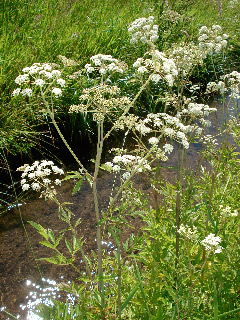| |
WEEDS!
By Jane Gilbertsen
Inside the Deer Fence
Dear Methow Gardener, If you are a gardener or gardener wannabe you must be sharing my current concerns with WEEDS! It is amazing how they go from not so scary to nightmares. Every year presents new challenges - either totally different weeds and a lot more of a particular kind. This year I hear lots of comments about the pervasiveness of mustard. (A personal concern of mine as it is teratogenic to equine foals.) Being an annual you need to pull it down and dispose of the whole plant without letting those pesky seed pods split open. Good luck with that.
 The weed I need to talk with you about today though is Western Water Hemlock. The MOST VIOLENTLY TOXIC plant in North America. Only a tiny amount causes horrible symptoms ending in death from respiratory paralysis. Cattle, goats, horses and an occasionally people are common victims. Craig Boesel has lost a horse and cow to this plant. Although all parts are poisonous the roots, specifically the top of the root, the juicy root crown, is the most poisonous. The weed I need to talk with you about today though is Western Water Hemlock. The MOST VIOLENTLY TOXIC plant in North America. Only a tiny amount causes horrible symptoms ending in death from respiratory paralysis. Cattle, goats, horses and an occasionally people are common victims. Craig Boesel has lost a horse and cow to this plant. Although all parts are poisonous the roots, specifically the top of the root, the juicy root crown, is the most poisonous.
Where would you find this nasty thing? Along your irrigation ditch bank for starters. Give it a moment and it will move out into wet meadows and downstream. Our is along the Fulton irrigation ditch. Control and elimination of this weed requires elimination of the weed along the entire waterway. Once it has a toehold on the ditch banks it marches out til it runs out of water. Therefore, irrigated fields of domestic stock and hay for domestic stock are vulnerable.
How to stop it now that it has a run on us? That is tough. In our little neighborhood it was sprayed after the ditch was off in the fall and then the ditch banks were burned in the spring. That cleaned it up for a couple years but now it is back as upditch owners and the ditch company did not control the hemlock.
It is important to prevent it from going to seed but spraying near water is a problem. The herbicides recommended are
1) Roundup (never ever use near water as the chemical does not break down it just keeps working in water to kill flora and fauna!),
2) 2,4D products which should not be used near water but maybe somewhat less evil, and
3) picloram (Tordon or Grazon), also not good near water. Before flowering a chemical called MCPA is also recommended. MCPA and Tordon/Grazon require a licensed spray professional. Those guys do not use chemicals against the label warnings. What is even worse is that the literature says it increases its toxicity for several weeks just after it is sprayed. That is sick.
So how to stop it now in the flowering stage? I don't know. Maybe cut the flower heads, wait til fall then spray? OR...pull it. I hate this "solution".
 The Cooperative Extention of University of Nevada says it is easy to pull in wet areas. I might try it but I will be sure to cover my mouth and throw away my full length all rubber gloves and all my clothes. I will put plastic bags over my shoes as they might be the surface that gets covered with the poison liquid that fills those root crown chambers - CIRCUTOXIN - toxin in unsaturated alcohol with a carrot-like odor. YUCK. If I get up the courage to do this I will write next week if I am still alive. The Cooperative Extention of University of Nevada says it is easy to pull in wet areas. I might try it but I will be sure to cover my mouth and throw away my full length all rubber gloves and all my clothes. I will put plastic bags over my shoes as they might be the surface that gets covered with the poison liquid that fills those root crown chambers - CIRCUTOXIN - toxin in unsaturated alcohol with a carrot-like odor. YUCK. If I get up the courage to do this I will write next week if I am still alive.
On a happier note, here is a photo of my most favorite flower, another poisonous plant, but one so beautiful you have to forgive it. Delphiniums in the color heaven must be! I grow these beauties in the most obscure place in my garden so no overhead sprinkler knocks them to the ground. They stay pristine til I have the courage to cut them for the house. And yes, they are behind the deer fence (for their own protection!
 Jane Jane
July 14, 2011
|
|

